A Comparative Analysis for Defining the Sliding Surface and Internal Structure in an Active Landslide Using the HVSR Passive Geophysical Technique in Pujilí (Cotopaxi), Ecuador
Abstract
1. Introduction
2. Geographical Setting and Geological Framework
3. Background and Methods
3.1. Geophysical Methods
3.2. Research Methodology
3.3. Seismic-Active-Techniques Surveys
3.4. Seismic Passive-HVSR-Technique Surveys
3.5. Vulnerability Index (Kg)
4. Results and Analysis of the Data
4.1. Seismic Refraction: Compressional Velocity (Vp) Model
4.2. MASW Technique: Shear Velocity (Vs) Distribution and Constrained-Model Definition
4.3. HVSR Data Results: Natural Frequency (fo) Determination
4.4. Ellipticity-Curve Inversion
4.5. Thickness Calculation
4.6. Directivity (Azimuthal) Values
4.7. Vulnerability Index (Kg)
5. Discussion
6. Conclusions
Author Contributions
Funding
Institutional Review Board Statement
Informed Consent Statement
Data Availability Statement
Acknowledgments
Conflicts of Interest
References
- EM-DAT: The OFDA/CRED International Disaster Database; Centre for Research on the Epidemiology of Disasters—CRED, Université Catholique de Louvain: Brussels, Belgium. 2022. Available online: https://www.emdat.be/ (accessed on 20 April 2022).
- Cruden, D.M.; Varnes, D.J. Landslide Types and Processes. In Landslides: Investigation and Mitigation; Turner, A.K., Shuster, R.L., Eds.; Transportation Research Board: Washington, DC, USA, 1996; Volume 247, pp. 36–75. [Google Scholar]
- Hungr, O.; Leroueil, S.; Picarelli, L. The Varnes classification of landslide types, an update. Landslides 2014, 11, 167–194. [Google Scholar] [CrossRef]
- Dikau, R.; Brunsden, D.; Schrott, L.; Ibsen, L. Landslide Recognition. Identification, Movement and Causes; John Wiley & Sons Ltd.: Chichester, UK, 1996. [Google Scholar]
- Wan, M.S.P.; Standing, J.R. Lessons learnt from installation of field instrumentation. Proc. Inst. Civ. Eng. Geotech. Eng. 2014, 167, 491–506. [Google Scholar] [CrossRef]
- Fell, R.; Hungr, O.; Leroueil, S.; Riemer, W. Geotechnical Engineering of the Stability of Natural Slopes and Cuts and Fills in Soil. In Proc. GeoEng; Technomic Publishing: Melbourne, Australia, 2000; Volume 1, pp. 21–120. [Google Scholar]
- McCann, D.M.; Forster, A. Reconnaissance Geophysical Methods in Landslide Investigations. Eng. Geol. 1990, 29, 59–78. [Google Scholar] [CrossRef]
- Gallipoli, M.; Lapenna, V.; Lorenzo, P.; Mucciarelli, M.; Perrone, A.; Piscitelli, S.; Sdao, F. Comparison of Geological and Geophysical Prospecting Techniques in the Study of a Landslide in Southern Italy. Eur. J. Environ. Eng. Geophys. 2000, 4, 117–128. [Google Scholar]
- Jongmans, D.; Garambois, S. Geophysical Investigation of Landslides: A Review. Bull. Société Géologique Fr. 2007, 178, 101–112. [Google Scholar] [CrossRef]
- Delgado, J.; Garrido, J.; Lenti, L.; Lopez-Casado, C.; Martino, S.; Sierra, F.J. Unconventional Pseudostatic Stability Analysis of the Diezma Landslide (Granada, Spain) Based on a High-Resolution Engineering-Geological Model. Eng. Geol. 2015, 184, 81–95. [Google Scholar] [CrossRef]
- Albarello, D.; Lunedei, E. Alternative Interpretations of Horizontal to Vertical Spectral Ratios of Ambient Vibrations: New Insights from Theoretical Modeling. Bull. Earthq. Eng. 2010, 8, 519–534. [Google Scholar] [CrossRef]
- Sebastiano, D.; Francesco, P.; Salvatore, M.; Roberto, I.; Antonella, P.; Giuseppe, L.; Pauline, G.; Daniela, F. Ambient Noise Techniques to Study Near-Surface in Particular Geological Conditions: A Brief Review. In Innovation in Near-Surface Geophysics; Elsevier: Amsterdam, The Netherlands, 2019; pp. 419–460. ISBN 978-0-12-812429-1. [Google Scholar]
- Delgado, J.; López Casado, C.; Giner, J.; Estévez, A.; Cuenca, A.; Molina, S. Microtremors as a Geophysical Exploration Tool: Applications and Limitations. Pure Appl. Geophys. 2000, 157, 1445–1462. [Google Scholar] [CrossRef]
- Nogoshi, M.; Igarashi, T. On the Amplitude Characteristics of Microtremor (Part 2). J. Seismol. Soc. Jpn. 1971, 24, 26–40. [Google Scholar]
- Nakamura, Y. A Method for Dynamic Characteristics Estimation of Subsurface Using Microtremor on the Ground Surface. Q. Rep. Railw. Tech. Res. 1989, 30, 25–33. [Google Scholar]
- Nakamura, Y. Clear Identification of Fundamental Idea of Nakamura’s Technique and Its Applications. In Proceedings of the 12th World Conference on Earthquake Engineering, Auckland, New Zealand, 30 January–4 February 2000. [Google Scholar]
- Colombero, C.; Comina, C.; De Toma, E.; Franco, D.; Godio, A. Ice Thickness Estimation from Geophysical Investigations on the Terminal Lobes of Belvedere Glacier (NW Italian Alps). Remote Sens. 2019, 11, 805. [Google Scholar] [CrossRef]
- Delgado, J.; López Casado, C.; Estévez, A.; Giner, J.; Cuenca, A.; Molina, S. Mapping Soft Soils in the Segura River Valley (SE Spain): A Case Study of Microtremors as an Exploration Tool. J. Appl. Geophys. 2000, 45, 19–32. [Google Scholar] [CrossRef]
- Alonso-Pandavenes, O.; Torres, G.; Torrijo, F.J.; Garzón-Roca, J. Basement Tectonic Structure and Sediment Thickness of a Valley Defined Using HVSR Geophysical Investigation, Azuela Valley, Ecuador. Bull. Eng. Geol. Environ. 2022, 81, 210. [Google Scholar] [CrossRef]
- Issaadi, A.; Saadi, A.; Semmane, F.; Yelles-Chaouche, A.; Galiana-Merino, J.J. Liquefaction Potential and Vs30 Structure in the Middle-Chelif Basin, Northwestern Algeria, by Ambient Vibration Data Inversion. Appl. Sci. 2022, 12, 8069. [Google Scholar] [CrossRef]
- Delgado, J.; Galiana-Merino, J.J.; García-Tortosa, F.J.; Garrido, J.; Lenti, L.; Martino, S.; Peláez, J.A.; Rodríguez-Peces, M.J.; de Galdeano, C.S.; Soler-Llorens, J.L. Ambient Noise Measurements to Constrain the Geological Structure of the Güevéjar Landslide (S Spain). Appl. Sci. 2021, 11, 1454. [Google Scholar] [CrossRef]
- Hussain, Y.; Martinez-Carvajal, H.; Condori, C.; Uagoda, R.; Cárdenas-Soto, M.; Cavalcante, A.L.B.; Da Cunha, L.S.; Martino, S. Ambient Seismic Noise: A Continuous Source for the Dynamic Monitoring of Landslides. Terrae Didat. 2019, 15, e019012. [Google Scholar]
- Hussain, Y.; Martinez-Carvajal, H.; Cárdenas-Soto, M.; Uagoda, R.E.S. Analysis of Surface Waves Recorded at a Mass Movement in Brasília, Brazil: An Im-Plication in Hazard Mitigation. Geociencias 2018, 37, 385–391. [Google Scholar] [CrossRef]
- Yuliyanto, G.; Harmoko, U.; Widada, S. Identification of Potential Ground Motion Using the HVSR Ground Shear Strain Approach in Wirogomo Area, Banyubiru Subdistrict, Semarang Regency. Int. J. Appl. Environ. Sci. 2016, 11, 1497–1507. [Google Scholar]
- Ibragimov, A. Use HVSR Method at Studying Structure of Landslides. Geophys. Res. Abstr. 2010, 12, 6191. [Google Scholar]
- Pischiutta, M.; Fondriest, M.; Demurtas, M.; Magnoni, F.; Di Toro, G.; Rovelli, A. Structural Control on the Directional Amplification of Seismic Noise (Campo Imperatore, Central Italy). Earth Planet. Sci. Lett. 2017, 471, 10–18. [Google Scholar] [CrossRef]
- Yuliyanto, G.; Harmoko, U.; Widada, S. Identify the Slip Surface of Land Slide in Wirogomo Banyubiru Semarang Regency Using HVSR Method. Int. J. Appl. Environ. Sci. 2017, 12, 2069–2078. [Google Scholar]
- Hussain, Y.; Cardenas-Soto, M.; Moreira, C.; Rodriguez-Rebolledo, J.; Hamza, O.; Prado, R.; Martinez-Carvajal, H.; Dou, J. Variation in Rayleigh Wave Ellipticity as a Possible Indicator of Earthflow Mobility: A Case Study of Sobradinho Landslide Compared with Pile Load Testing. Earth Sci. Res. J. 2020, 24, 141–151. [Google Scholar] [CrossRef]
- Kakhki, M.K.; Peters, F.C.; Mansur, W.J.; SadidKhoii, A.; Rezaei, S. Deciphering Site Response Directivity in Landslide-Prone Slopes from Ambient Noise Spectral Analysis. Eng. Geol. 2020, 269, 105542. [Google Scholar] [CrossRef]
- Yuliyanto, G.; Nurwidyanto, M.I. Analysis of Landslide in Bungkah, Sepakung, Banyubiru Using Ground Shear Strain Method and Shear Wave Profile from HVSR Method. J. Phys. Conf. Ser. 2021, 1943, 012027. [Google Scholar] [CrossRef]
- Alonso-Pandavenes, O.; Torrijo, F.J.; Garzón-Roca, J.; Gracia, A. Early Investigation of a Landslide Sliding Surface by HVSR and VES Geophysical Techniques Combined. A Case Study in Guarumales (Ecuador). Appl. Sci. 2023, 13, 1023. [Google Scholar] [CrossRef]
- D’Ercole, R.; Trujillo, M. Amenazas, Vulnerabilidad, Capacidades y Riesgos En El Ecuador. Los Desastres, Un Reto Para El Desarrollo; COOPI, IRD, OXFAM Editors: Quito, Ecuador, 2003; ISBN 9978-42-972-7. [Google Scholar]
- Burga, S. Caracterización litológica—Estructural y Evaluación de los Deslizamientos en la Zona de Cachi, Pujilí, Provincia de Cotopaxi. Geology Engineering. Bachelor’s Thesis, Central University of Ecuador, Quito, Ecuador, 2019. Available online: http://www.dspace.uce.edu.ec/handle/25000/19426 (accessed on 11 May 2022).
- Pilatasig, L.; Bustillos, J.; Jácome, F.; Mariño, D. Evaluación de la Actividad de los Movimientos en Masa de Cachi Alto-Pujilí, Ecuador Mediante Monitoreo Instrumental de Bajo Costo. RP 2022, 49, 19–30. [Google Scholar] [CrossRef]
- Analuisa, E.E. Estabilización de Laderas en la Zona del Deslizamiento de Cachi, Ubicado en la Parroquia y Cantón Pujilí, Provincia de Cotopaxi. Mining Engineering. Bachelor’s Thesis, Central University of Ecuador, Quito, Ecuador, 2019. Available online: http://www.dspace.uce.edu.ec/handle/25000/18532 (accessed on 1 June 2022).
- Bernal, C.D. Caracterización Mediante Métodos de Sísmica Pasiva (HVSR) de un Deslizamiento Activo de Mediana Magnitud Ubicado al Este del Sector de Cachi Alto, Cantón Pujilí, Provincia de Cotopaxi. Geology Engineering. Bachelor’s Thesis, Central University of Ecuador, Quito, Ecuador, 2021. Available online: http://www.dspace.uce.edu.ec/handle/25000/25532 (accessed on 17 March 2022).
- Guéguen, P.; Chatelain, J.-L.; Guillier, B.; Yepes, H.; Egred, J. Site Effect and Damage Distribution in Pujili (Ecuador) after the 28 March 1996 Earthquake. Soil Dyn. Earthq. Eng. 1998, 17, 329–334. [Google Scholar] [CrossRef]
- Xu, R.; Wang, L. The Horizontal-to-Vertical Spectral Ratio and Its Applications. EURASIP J. Adv. Signal Process. 2021, 2021, 75. [Google Scholar] [CrossRef]
- Boore, D.M. Estimating s(30) (or NEHRP Site Classes) from Shallow Velocity Models (Depths < 30 m). Bull. Seismol. Soc. Am. 2004, 94, 591–597. [Google Scholar] [CrossRef]
- Oubaiche, E.H.; Chatelain, J.-L.; Bouguern, A.; Bensalem, R.; Machane, D.; Hellel, M.; Khaldaoui, F.; Guillier, B. Experimental Relationship Between Ambient Vibration H/V Peak Amplitude and Shear-Wave Velocity Contrast. Seismol. Res. Lett. 2012, 83, 1038–1046. [Google Scholar] [CrossRef]
- Lermo, J.; Chávez García, F. Site Effect Evaluation Using Microtremor Measurements: A Review in Three Cities in Mexico and Results of a New Technique. Memoria 1992, 144–155. [Google Scholar]
- Field, E.; Jacob, K. The Theoretical Response of Sedimentary Layers to Ambient Seismic Noise. Geophys. Res. Lett. 1993, 20, 2925–2928. [Google Scholar] [CrossRef]
- Bottelin, P.; Baillet, L.; Carrier, A.; Larose, E.; Jongmans, D.; Brenguier, O.; Cadet, H. Toward Workable and Cost-Efficient Monitoring of Unstable Rock Compartments with Ambient Noise. Geosciences 2021, 11, 242. [Google Scholar] [CrossRef]
- Fäh, D.; Kind, F.; Giardini, D. A Theoretical Investigation of Average H/V Ratios. Geophys. J. Int. 2001, 145, 535–549. [Google Scholar] [CrossRef]
- Kanlı, A.I.; Tildy, P.; Prónay, Z.; Pınar, A.; Hermann, L. Vs30 Mapping and Soil Classification for Seismic Site Effect Evaluation in Dinar Region, SW Turkey. Geophys. J. Int. 2006, 165, 223–235. [Google Scholar] [CrossRef]
- Pamuk, E.; Özdağ, Ö.C.; Akgün, M. Soil Characterization of Bornova Plain (Izmir, Turkey) and Its Surroundings Using a Combined Survey of MASW and ReMi Methods and Nakamura’s (HVSR) Technique. Bull. Eng. Geol. Environ. 2019, 78, 3023–3035. [Google Scholar] [CrossRef]
- Abate, G.; Corsico, S.; Grasso, S.; Massimino, M.R. An Early-Warning System to Validate the Soil Profile during TBM Tunnelling. Geosciences 2022, 12, 113. [Google Scholar] [CrossRef]
- Wang, H.; Wang, P.; Yu, Y.; Xu, S.; Guo, H.; Pu, X. Applicability of HVSR in Site Effect of Loess Slope Covered on Mud Rock. IOP Conf. Ser. Earth Environ. Sci. 2019, 304, 052096. [Google Scholar] [CrossRef]
- Castellaro, S.; Mulargia, F. Vs30 Estimates Using Constrained H/V Measurements. Bull. Seismol. Soc. Am. 2009, 99, 761–773. [Google Scholar] [CrossRef]
- Castellaro, S.; Mulargia, F. The Effect of Velocity Inversions on H/V. Pure Appl. Geophys. 2009, 166, 567–592. [Google Scholar] [CrossRef]
- Bonnefoy-Claudet, S.; Cotton, F.; Bard, P.-Y. The Nature of Noise Wavefield and Its Applications for Site Effects Studies. Earth-Sci. Rev. 2006, 79, 205–227. [Google Scholar] [CrossRef]
- Del Gaudio, V.; Wasowski, J.; Muscillo, S. New Developments in Ambient Noise Analysis to Characterise the Seismic Response of Landslide-Prone Slopes. Nat. Hazards Earth Syst. Sci. 2013, 13, 2075–2087. [Google Scholar] [CrossRef]
- Martorana, R.; Capizzi, P.; Avellone, G.; D’Alessandro, A.; Siragusa, R.; Luzio, D. Assessment of a Geological Model by Surface Wave Analyses. J. Geophys. Eng. 2017, 14, 159–172. [Google Scholar] [CrossRef]
- Burjánek, J.; Gassner-Stamm, G.; Poggi, V.; Moore, J.R.; Fäh, D. Ambient Vibration Analysis of an Unstable Mountain Slope. Geophys. J. Int. 2010, 180, 820–828. [Google Scholar] [CrossRef]
- Imposa, S.; Grassi, S.; Fazio, F.; Rannisi, G.; Cino, P. Geophysical Surveys to Study a Landslide Body (North-Eastern Sicily). Nat. Hazards 2017, 86, 327–343. [Google Scholar] [CrossRef]
- Bonamassa, O.; Vidale, J.E. Directional Site Resonances Observed from Aftershocks of the 18 October 1989 Loma Prieta Earthquake. Bull. Seismol. Soc. Am. 1991, 81, 1945–1957. [Google Scholar]
- Moore, J.R.; Gischig, V.; Burjanek, J.; Loew, S.; Fah, D. Site Effects in Unstable Rock Slopes: Dynamic Behavior of the Randa Instability (Switzerland). Bull. Seismol. Soc. Am. 2011, 101, 3110–3116. [Google Scholar] [CrossRef]
- Telford, W.M.; Geldart, L.P.; Sheriff, R.E. Applied Geophysics, 2nd ed.; Cambridge University Press: Cambridge, UK, 1990; ISBN 978-0-521-33938-4. [Google Scholar]
- González, J.; Schmitz, M. Caracterización dinámica de perfiles geotécnicos de Cariaco (estado Sucre, Venezuela), partiendo de datos de refracción sísmica. Rev. Fac. Ing. Univ. Cent. Venez. 2008, 23, 83–93. [Google Scholar]
- Park, C.B.; Miller, R.D.; Xia, J. Multichannel Analysis of Surface Waves. Geophysics 1999, 64, 800–808. [Google Scholar] [CrossRef]
- Park, C.B.; Miller, R.D.; Xia, J.; Ivanov, J. Multichannel Analysis of Surface Waves (MASW)—Active and Passive Methods. Lead. Edge 2007, 26, 60–64. [Google Scholar] [CrossRef]
- Budi, A.P.; Ginting, R.A.; Sunardi, B.; Sukanta, I.N. Combination of Passive Seismic (HVSR) and Active Seismic (MASW) Methods to Obtain Shear Wave Velocity Model of Subsurface in Majalengka. J. Phys. Conf. Ser. 2021, 1805, 012002. [Google Scholar] [CrossRef]
- Xia, J.; Miller, R.D.; Park, C.B. Estimation of Near-surface Shear-wave Velocity by Inversion of Rayleigh Waves. Geophysics 1999, 64, 691–700. [Google Scholar] [CrossRef]
- Council, Building Seismic Safety. In NEHRP Recommended Provisions for Seismic Regulations for New Buildings and Other Structures; Part1 Provisions; FEMA302: Washington, DC, USA, 1997. Available online: https://www.nehrp.gov/ (accessed on 20 April 2022).
- NEC-SD-DS Peligro Sísmico, Diseño Sísmo Resistente 2015. Ecuador Republic Government. Quito. Available online: https://www.habitatyvivienda.gob.ec/ (accessed on 20 April 2022).
- Le Breton, M.; Bontemps, N.; Guillemot, A.; Baillet, L.; Larose, É. Landslide Monitoring Using Seismic Ambient Noise Correlation: Challenges and Applications. Earth-Sci. Rev. 2021, 216, 103518. [Google Scholar] [CrossRef]
- Del Gaudio, V.; Coccia, S.; Wasowski, J.; Gallipoli, M.R.; Mucciarelli, M. Detection of Directivity in Seismic Site Response from Microtremor Spectral Analysis. Nat. Hazards Earth Syst. Sci. 2008, 8, 751–762. [Google Scholar] [CrossRef]
- Geopsy Project. SESAME European Project EVG1-CT-2000-00026, Université de Liège, Belgium. Available online: https://geopsy.org (accessed on 22 March 2022).
- SESAME Project. Guidelines for the Implementation of the H/V Spectral Ratio Technique on Ambient Vibrations Measurements, Processing and Interpretation; European Research Project WP12; European Commission: Brussels, Belgium, 2004; p. 62. [Google Scholar]
- Wathelet, M.; Chatelain, J.-L.; Cornou, C.; Di Giulio, G.; Guillier, B.; Ohrnberger, M.; Savvaidis, A. Geopsy: A User-Friendly Open-Source Tool Set for Ambient Vibration Processing. Seismol. Res. Lett. 2020, 91, 1878–1889. [Google Scholar] [CrossRef]
- Konno, K.; Ohmachi, T. Ground-Motion Characteristics Estimated from Spectral Ratio between Horizontal and Vertical Components of Microtremor. Bull. Seismol. Soc. Am. 1998, 88, 228–241. [Google Scholar] [CrossRef]
- Bard, P.-Y. Foreword: The H/V Technique: Capabilities and Limitations Based on the Results of the SESAME Project. Bull Earthq. Eng 2008, 6, 1–2. [Google Scholar] [CrossRef]
- Wathelet, M.; Jongmans, D.; Ohrnberger, M. Surface-Wave Inversion Using a Direct Search Algorithm and Its Application to Ambient Vibration Measurements. Near Surf. Geophys. 2004, 2, 211–221. [Google Scholar] [CrossRef]
- Panzera, F.; D’Amico, S.; Lotteri, A.; Galea, P.; Lombardo, G. Seismic Site Response of Unstable Steep Slope Using Noise Measurements: The Case Study of Xemxija Bay Area, Malta. Nat. Hazards Earth Syst. Sci. 2012, 12, 3421–3431. [Google Scholar] [CrossRef]
- Panzera, F.; Lombardo, G.; DAmico, S.; Gale, P. Speedy Techniques to Evaluate Seismic Site Effects in Particular Geomorphologic Conditions: Faults, Cavities, Landslides and Topographic Irregularities. In Engineering Seismology, Geotechnical and Structural Earthquake Engineering; DAmico, S., Ed.; InTech: London, UK, 2013; ISBN 978-953-51-1038-5. [Google Scholar]
- Guillier, B.; Chatelain, J.-L.; Bonnefoy-Claudet, S.; Haghshenas, E. Use of Ambient Noise: From Spectral Amplitude Variability to H/V Stability. J. Earthq. Eng. 2007, 11, 925–942. [Google Scholar] [CrossRef]
- Garcia-Jerez, A. Characterization of the Sedimentary Cover of the Zafarraya Basin, Southern Spain, by Means of Ambient Noise. Bull. Seismol. Soc. Am. 2006, 96, 957–967. [Google Scholar] [CrossRef]
- Setiawan, B.; Jaksa, M.; Griffith, M.; Love, D. Seismic Site Classification Based on Constrained Modeling of Measured HVSR Curve in Regolith Sites. Soil Dyn. Earthq. Eng. 2018, 110, 244–261. [Google Scholar] [CrossRef]
- Farid, M. Microseismic Wave Measurements to Detect Landslides in Bengkulu Shore with Attenuation Coefficient and Shear Strain Indicator. KEG 2016, 1, 1–7. [Google Scholar] [CrossRef]
- Ibs-von Seht, M.; Wohlenberg, J. Microtremor Measurements Used to Map Thickness of Soft Sediments. Bull. Seismol. Soc. Am. 1999, 89, 250–259. [Google Scholar] [CrossRef]
- Khan, S.; Khan, M.A. Mapping Sediment Thickness of Islamabad City Using Empirical Relationships: Implications for Seismic Hazard Assessment. J. Earth Syst. Sci. 2016, 125, 623–644. [Google Scholar] [CrossRef]
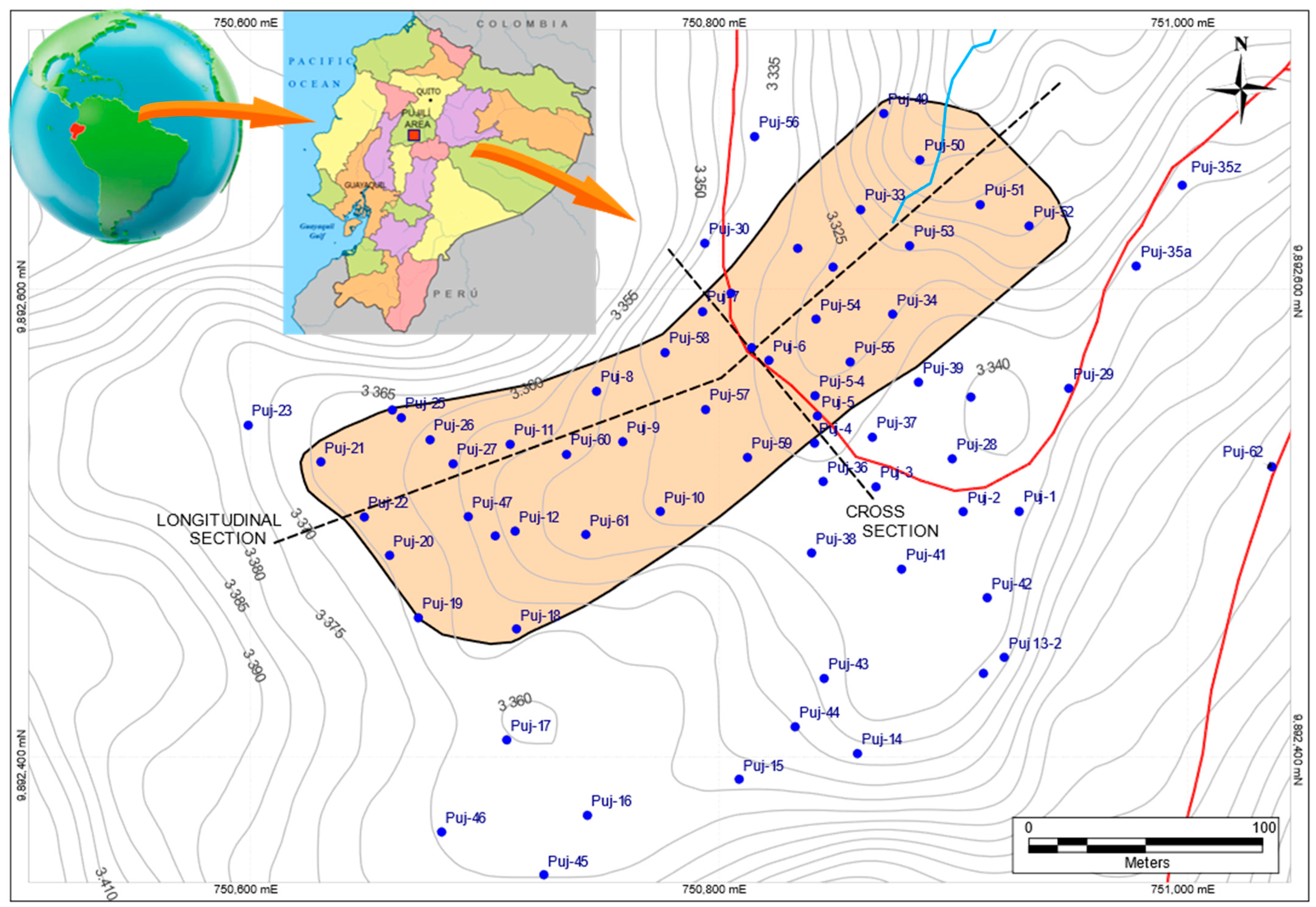
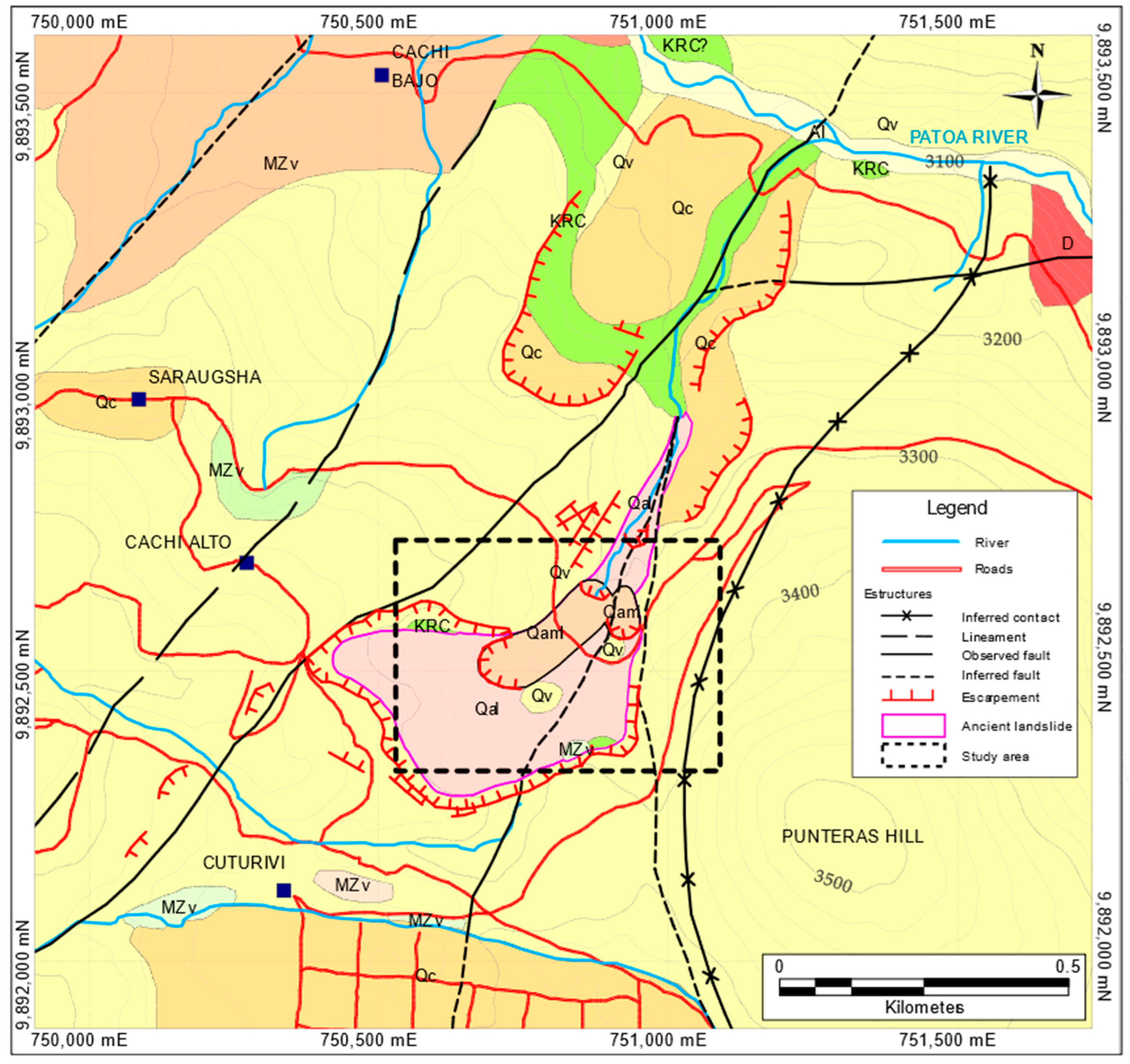


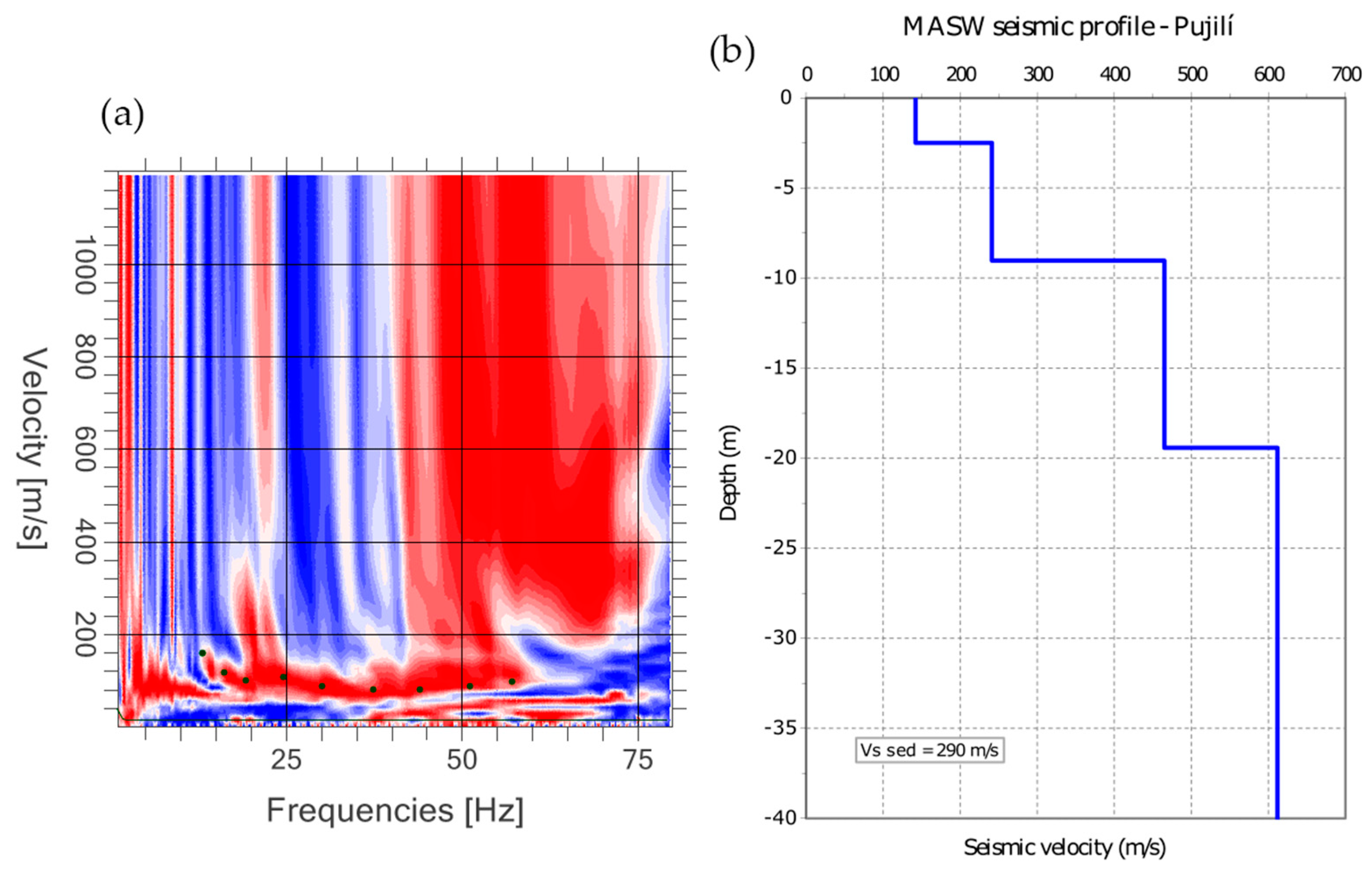
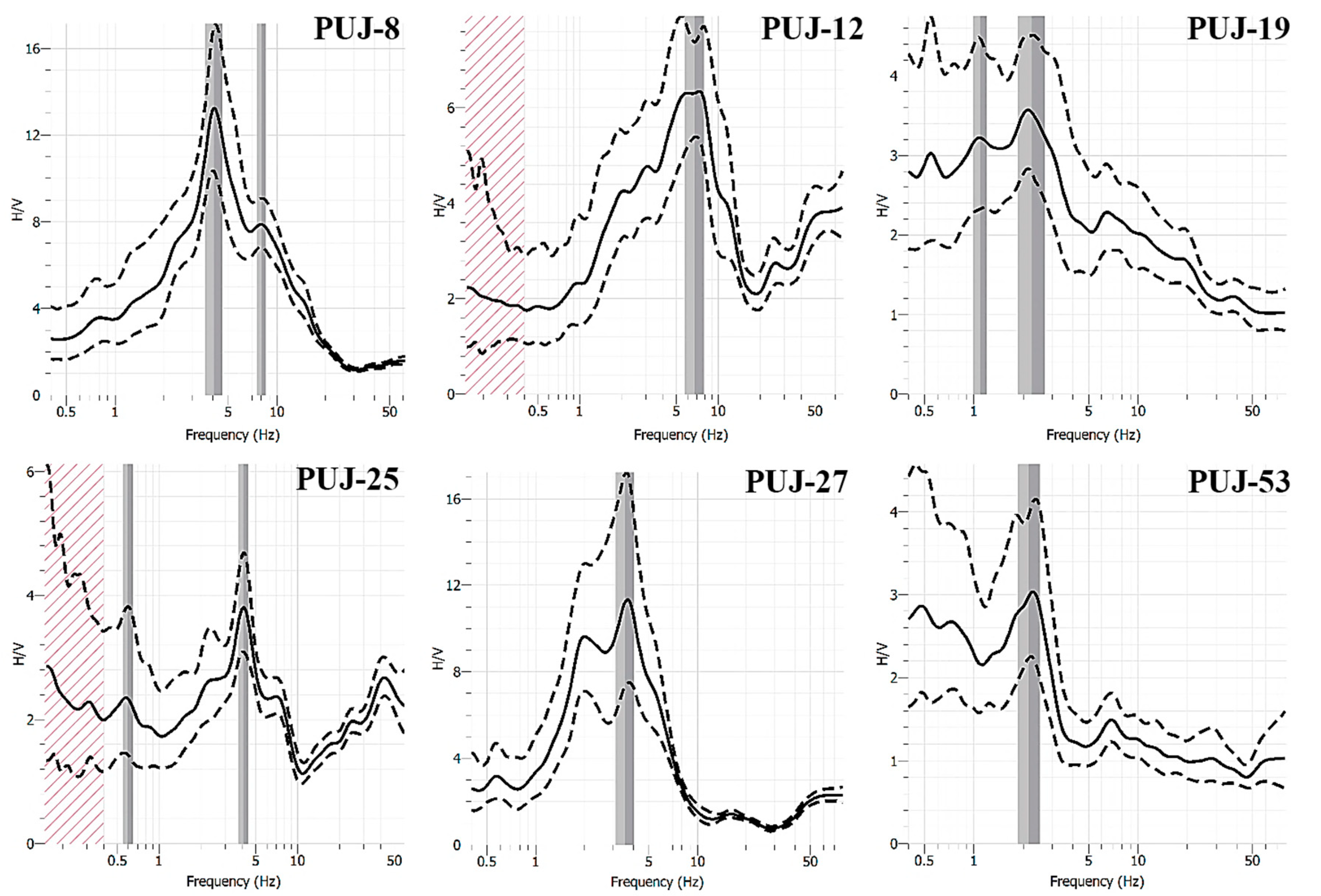
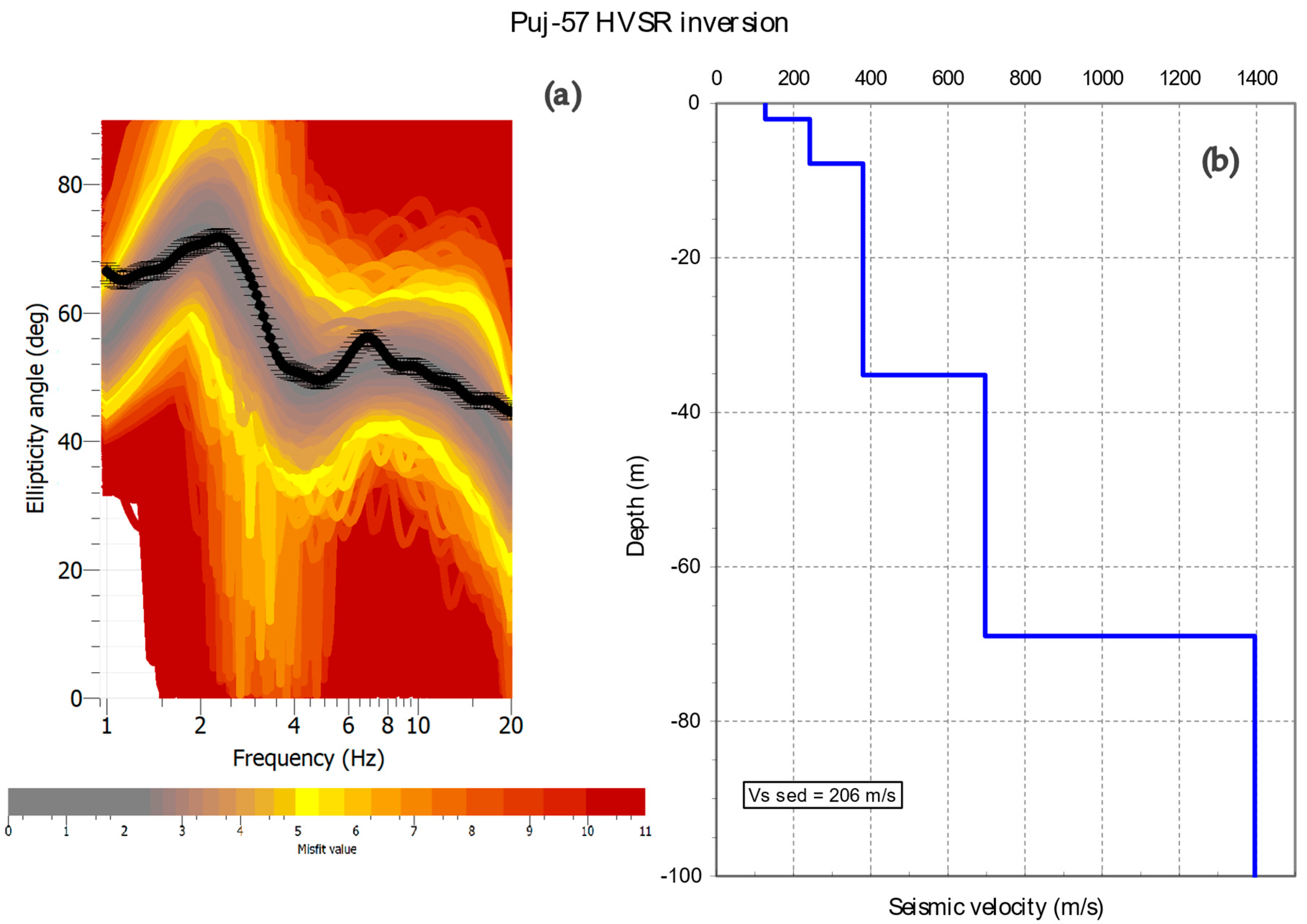

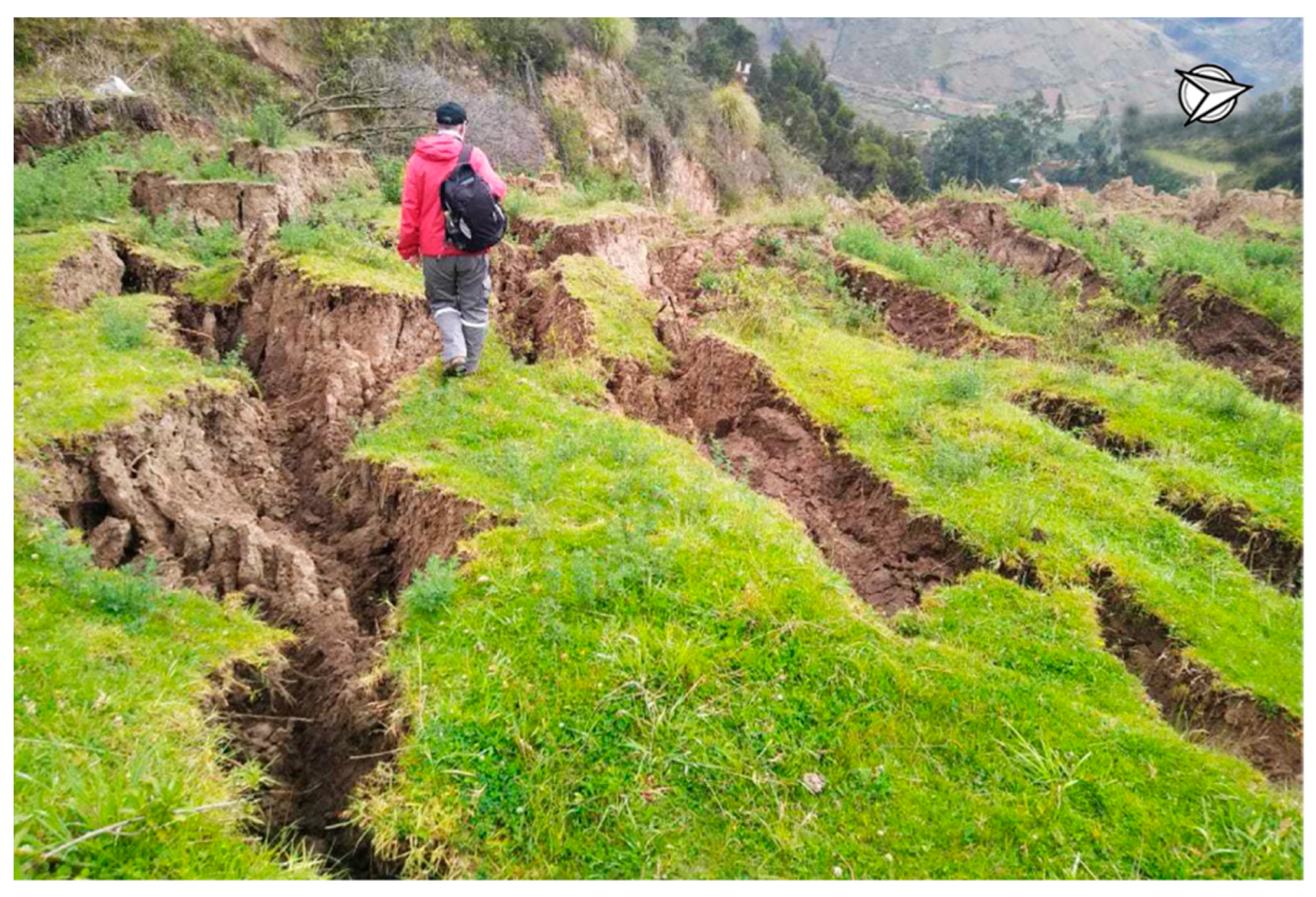
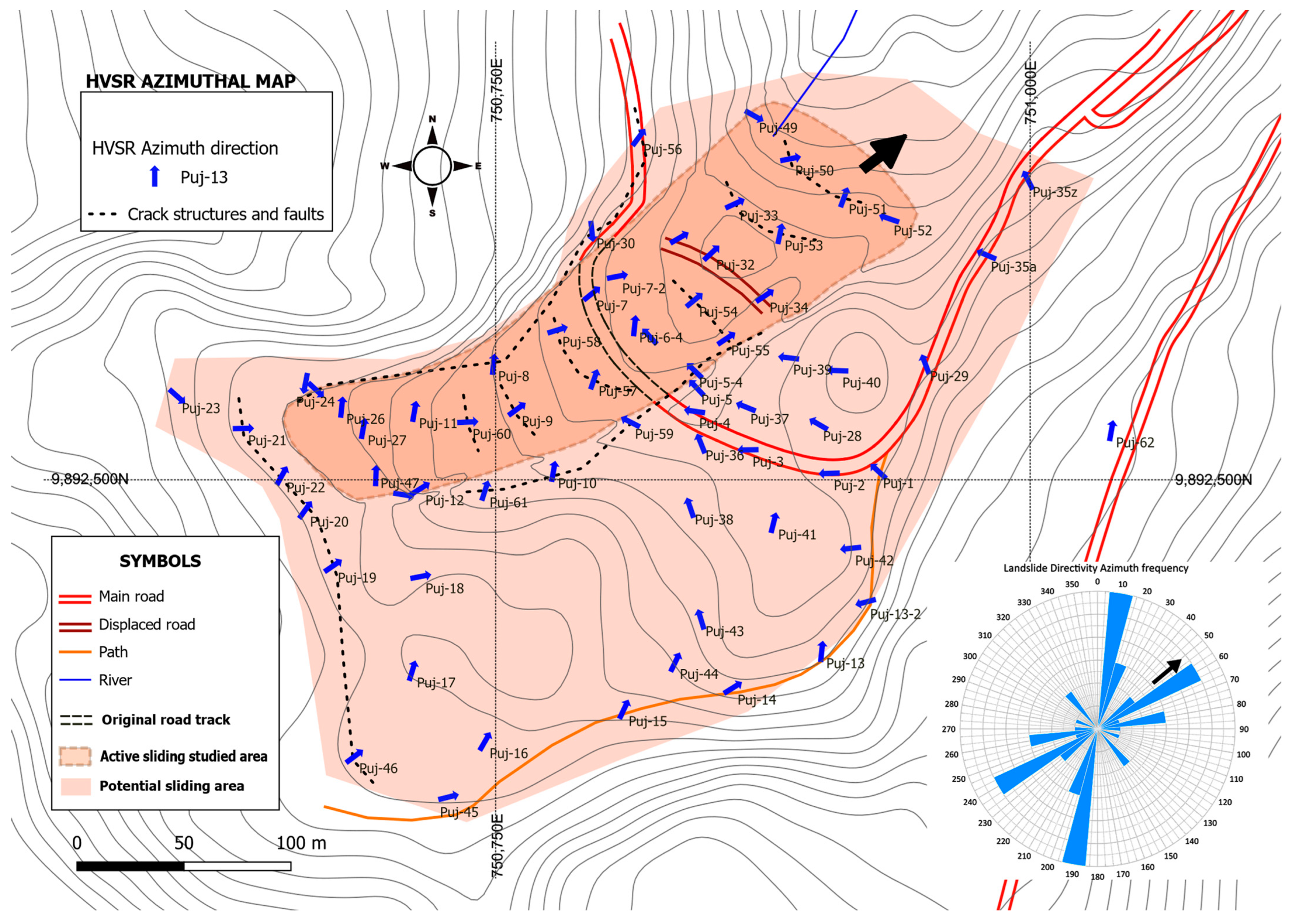
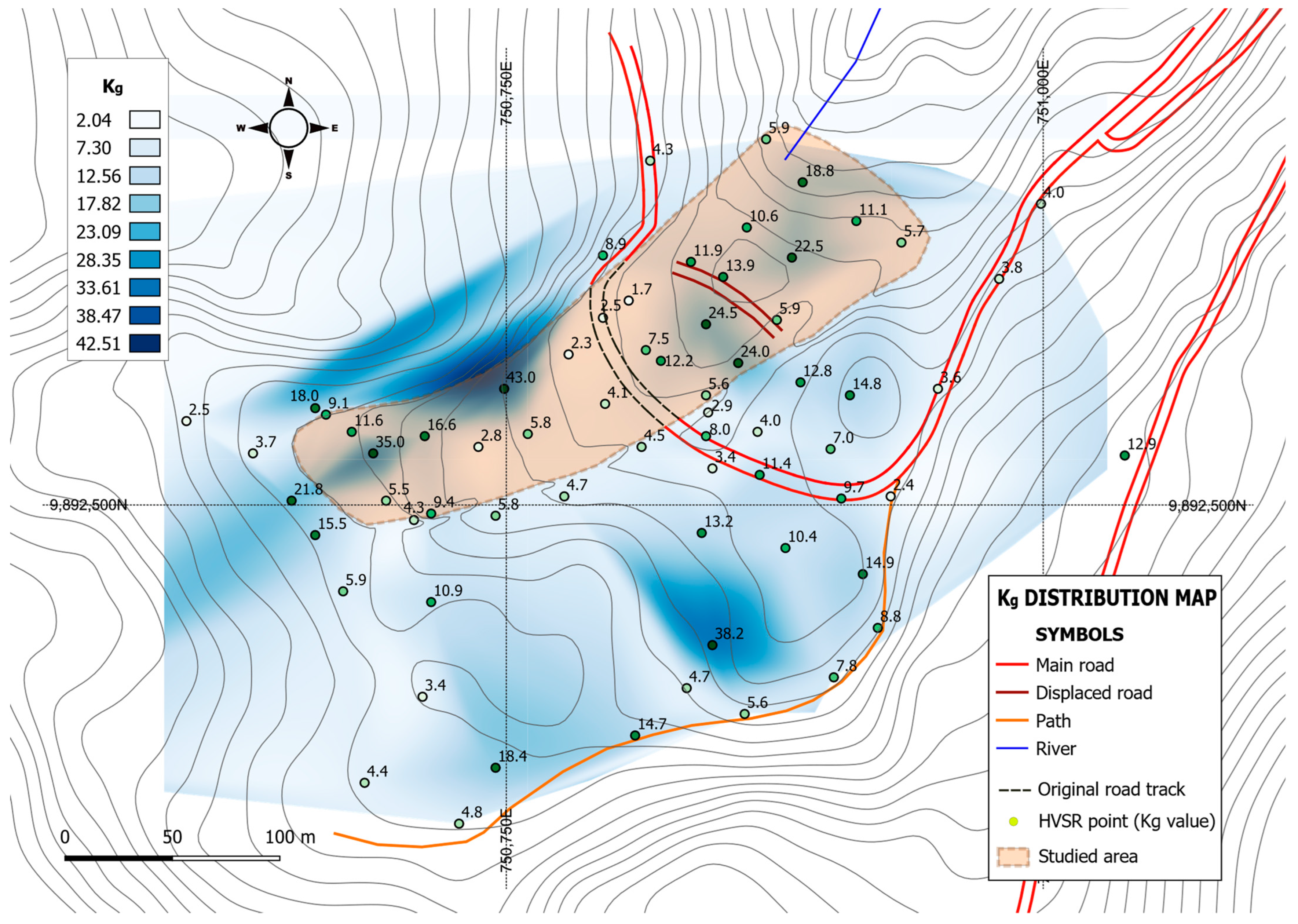
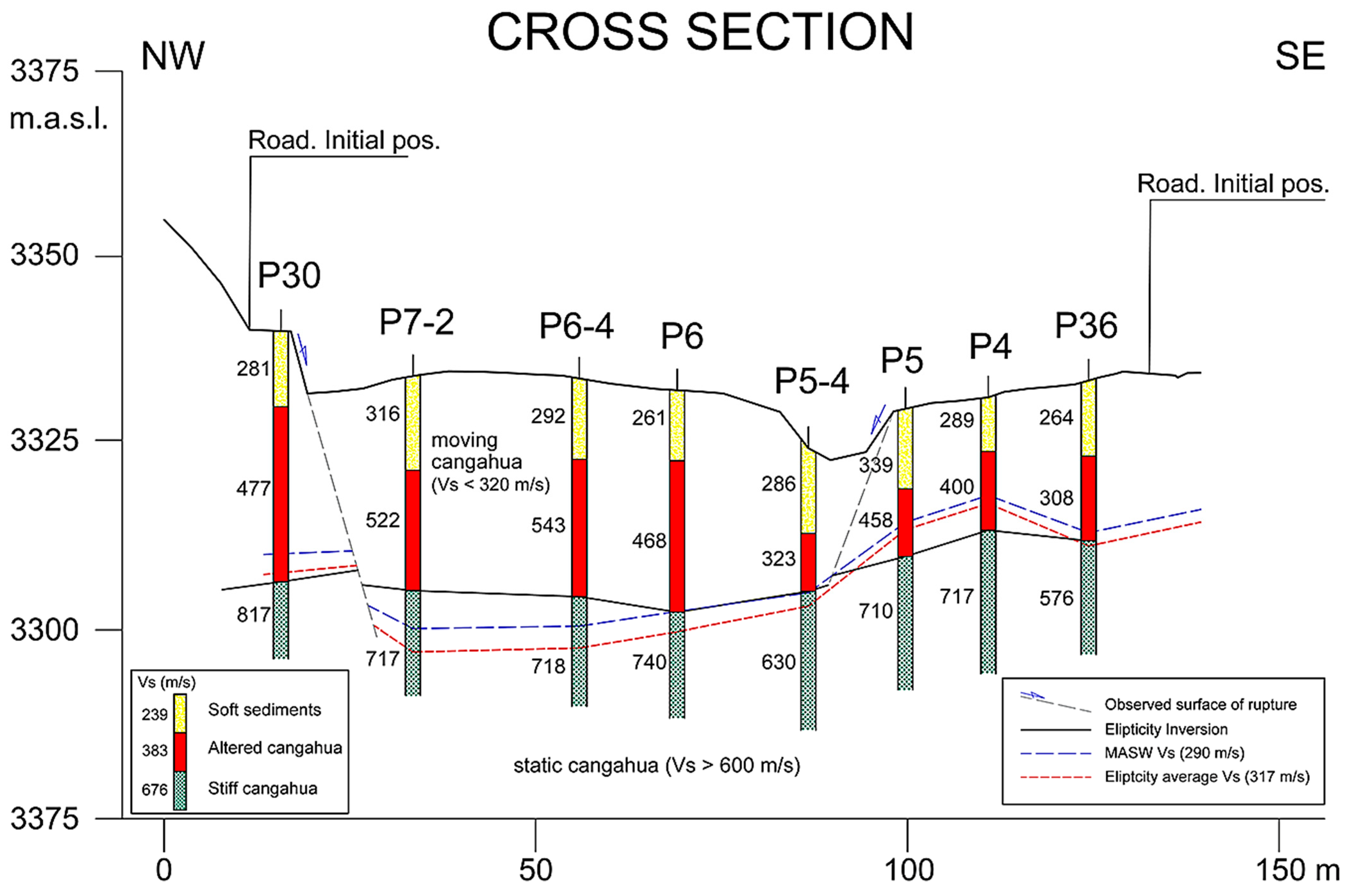

| Geophysical Levels | Velocity Interval (Vs) | Thickness | ||
|---|---|---|---|---|
| From (m/s) | To (m/s) | From (m) | To (m) | |
| GL-1 | 80 | 350 | 2.0 | 10.0 |
| GL-2 | 150 | 500 | 3.0 | 20.0 |
| GL-3 | 250 | 700 | 5.0 | 30.0 |
| GL-4 | 250 | 900 | 10.0 | 100.0 |
| GL-5 | 350 | 1500 | - | - |
| Point | fo (Hz) | Ao | Kg | Point | fo (Hz) | Ao | Kg |
|---|---|---|---|---|---|---|---|
| PUJ-1 | 3.31 | 2.80 | 2.37 | PUJ-35z | 2.33 | 3.06 | 4.02 |
| PUJ-2 | 4.08 | 3.35 | 2.75 | PUJ-36 | 12.50 | 3.49 | 0.97 |
| PUJ-3 | 3.94 | 2.41 | 1.47 | PUJ-37 | 1.84 | 2.71 | 3.99 |
| PUJ-4 | 5.51 | 4.67 | 3.96 | PUJ-38 | 3.45 | 2.43 | 1.71 |
| PUJ-5 | 4.75 | 1.94 | 0.79 | PUJ-39 | 2.00 | 5.06 | 12.80 |
| PUJ-6 | 2.43 | 5.44 | 12.18 | PUJ-40 | 3.60 | 7.31 | 14.84 |
| PUJ-7 | 2.15 | 2.33 | 2.53 | PUJ-41 | 1.75 | 1.67 | 1.59 |
| PUJ-8 | 4.08 | 13.24 | 42.97 | PUJ-42 | 1.73 | 2.81 | 4.56 |
| PUJ-9 | 2.60 | 3.90 | 5.85 | PUJ-43 | 3.34 | 4.03 | 4.86 |
| PUJ-10 | 2.58 | 3.47 | 4.67 | PUJ-44 | 6.03 | 4.64 | 3.57 |
| PUJ-11 | 2.91 | 2.62 | 2.36 | PUJ-45 | 1.63 | 2.79 | 4.78 |
| PUJ-12 | 2.25 | 3.54 | 5.57 | PUJ-46 | 1.78 | 2.80 | 4.40 |
| PUJ-13 | 2.34 | 2.18 | 2.03 | PUJ-47 | 3.00 | 3.03 | 3.06 |
| PUJ-14 | 4.26 | 4.89 | 5.61 | PUJ-48 | 2.22 | 3.08 | 4.27 |
| PUJ-15 | 7.06 | 3.78 | 2.02 | PUJ-49 | 3.12 | 4.28 | 5.87 |
| PUJ-16 | 1.51 | 3.28 | 7.12 | PUJ-50 | 9.59 | 14.82 | 22.90 |
| PUJ-17 | 1.73 | 2.43 | 3.41 | PUJ-51 | 6.97 | 5.58 | 4.47 |
| PUJ-18 | 1.59 | 4.16 | 10.88 | PUJ-52 | 5.85 | 2.35 | 0.94 |
| PUJ-19 | 6.76 | 6.30 | 5.87 | PUJ-53 | 2.56 | 2.68 | 2.81 |
| PUJ-20 | 2.90 | 6.70 | 15.48 | PUJ-54 | 2.09 | 3.60 | 6.20 |
| PUJ-21 | 3.84 | 3.79 | 3.74 | PUJ-55 | 1.78 | 3.76 | 7.94 |
| PUJ-22 | 4.84 | 10.27 | 21.79 | PUJ-56 | 2.84 | 3.49 | 4.29 |
| PUJ-23 | 3.98 | 3.12 | 2.45 | PUJ-57 | 2.17 | 2.98 | 4.09 |
| PUJ-24 | 2.15 | 2.85 | 3.78 | PUJ-58 | 2.31 | 2.30 | 2.29 |
| PUJ-25 | 4.08 | 3.80 | 3.54 | PUJ-59 | 1.80 | 2.85 | 4.51 |
| PUJ-26 | 2.33 | 5.20 | 11.61 | PUJ-60 | 2.31 | 2.54 | 2.79 |
| PUJ-27 | 3.57 | 11.17 | 34.95 | PUJ-61 | 1.93 | 3.35 | 5.81 |
| PUJ-28 | 4.01 | 2.43 | 1.47 | PUJ-62 | 2.10 | 2.81 | 3.76 |
| PUJ-29 | 2.00 | 2.68 | 3.59 | PUJ5-4 | 3.71 | 2.50 | 1.68 |
| PUJ-30 | 2.41 | 2.48 | 2.55 | PUJ6-4 | 2.20 | 4.06 | 7.49 |
| PUJ-31 | 3.24 | 1.91 | 1.13 | PUJ7-2 | 2.13 | 1.88 | 1.66 |
| PUJ-32 | 2.17 | 5.50 | 13.94 | PUJ13-2 | 2.30 | 2.23 | 2.16 |
| PUJ-33 | 2.18 | 4.81 | 10.61 | PUJ-200 | 2.34 | 3.93 | 6.60 |
| PUJ-34 | 5.40 | 2.28 | 0.96 | PUJ-201 | 2.01 | 2.24 | 2.50 |
| PUJ-35a | 2.41 | 3.01 | 3.76 | PUJ-202 | 1.22 | 4.28 | 15.02 |
| Hvsr Point | L1 Vs (m/s) | L2 Vs (m/s) | L3 Vs (m/s) | L4 Vs (m/s) | L5 Vs (m/s) | Vs sed (m/s) |
|---|---|---|---|---|---|---|
| PUJ-4 | 119 | 289 | 400 | 718 | 1354 | 289 |
| PUJ-5 | 134 | 339 | 458 | 710 | 1466 | 322 |
| PUJ-6 | 103 | 249 | 450 | 474 | 1467 | 305 |
| PUJ-7 | 110 | 292 | 502 | 740 | 1481 | 307 |
| PUJ-8 | 113 | 289 | 372 | 683 | 1496 | 257 |
| PUJ-9 | 107 | 254 | 473 | 770 | 1496 | 331 |
| PUJ-10 | 112 | 295 | 395 | 732 | 1496 | 277 |
| PUJ-11 | 109 | 273 | 415 | 697 | 1409 | 360 |
| PUJ-12 | 115 | 281 | 477 | 747 | 1467 | 334 |
| PUJ-20 | 109 | 284 | 577 | 793 | 1096 | 389 |
| PUJ-21 | 114 | 270 | 387 | 747 | 1424 | 296 |
| PUJ-22 | 110 | 289 | 369 | 725 | 1496 | 266 |
| PUJ-23 | 115 | 307 | 612 | 726 | 1409 | 391 |
| PUJ-25 | 124 | 316 | 612 | 754 | 1496 | 396 |
| PUJ-26 | 117 | 301 | 487 | 793 | 1481 | 319 |
| PUJ-27 | 117 | 239 | 383 | 676 | 1481 | 267 |
| PUJ-30 | 117 | 281 | 477 | 817 | 1467 | 357 |
| PUJ-31 | 133 | 304 | 419 | 676 | 1438 | 307 |
| PUJ-32 | 109 | 281 | 424 | 711 | 1496 | 303 |
| PUJ-33 | 107 | 286 | 554 | 711 | 1467 | 375 |
| PUJ-34 | 113 | 275 | 533 | 770 | 1496 | 354 |
| PUJ-36 | 105 | 264 | 308 | 576 | 1166 | 231 |
| PUJ-47 | 124 | 295 | 473 | 643 | 1438 | 304 |
| PUJ-49 | 117 | 289 | 317 | 697 | 1452 | 249 |
| PUJ-50 | 100 | 273 | 522 | 683 | 1496 | 342 |
| PUJ-51 | 120 | 307 | 560 | 785 | 1481 | 344 |
| PUJ-52 | 115 | 284 | 492 | 725 | 1467 | 324 |
| PUJ-53 | 127 | 275 | 354 | 565 | 1409 | 278 |
| PUJ-54 | 113 | 292 | 527 | 817 | 1481 | 385 |
| PUJ-55 | 114 | 275 | 380 | 612 | 1481 | 256 |
| PUJ-57 | 133 | 267 | 383 | 588 | 1251 | 206 |
| PUJ-58 | 149 | 333 | 450 | 754 | 1424 | 368 |
| PUJ-59 | 124 | 313 | 380 | 690 | 1467 | 284 |
| PUJ-60 | 135 | 304 | 468 | 793 | 1452 | 367 |
| PUJ-5-4 | 112 | 286 | 324 | 631 | 1496 | 256 |
| PUJ-6-4 | 114 | 292 | 543 | 718 | 1481 | 357 |
| PUJ-7-2 | 122 | 320 | 492 | 697 | 1481 | 330 |
| AVERAGES | 117 | 288 | 453 | 707 | 1441 | 317 |
| Hvsr Point | fo (Hz) | TH-1 (m) | TH-2 (m) | Hvsr Point | fo (Hz) | TH-1 (m) | TH-2 (m) |
|---|---|---|---|---|---|---|---|
| PUJ-1 | 3.31 | 21.9 | 23.9 | PUJ-35z | 2.33 | 31.1 | 34.0 |
| PUJ-2 | 4.08 | 17.8 | 19.4 | PUJ-36 | 12.50 | 5.8 | 6.3 |
| PUJ-3 | 3.94 | 18.4 | 20.1 | PUJ-37 | 1.84 | 39.4 | 43.1 |
| PUJ-4 | 5.51 | 13.2 | 14.4 | PUJ-38 | 3.45 | 21.0 | 23.0 |
| PUJ-5 | 4.75 | 15.3 | 16.7 | PUJ-39 | 2.00 | 36.3 | 39.6 |
| PUJ-6 | 2.43 | 29.8 | 32.6 | PUJ-40 | 3.60 | 20.1 | 22.0 |
| PUJ-7 | 2.15 | 33.7 | 36.9 | PUJ-41 | 1.75 | 41.4 | 45.3 |
| PUJ-8 | 4.08 | 17.8 | 19.4 | PUJ-42 | 1.73 | 41.9 | 45.8 |
| PUJ-9 | 2.60 | 27.9 | 30.5 | PUJ-43 | 3.34 | 21.7 | 23.7 |
| PUJ-10 | 2.58 | 28.1 | 30.7 | PUJ-44 | 6.03 | 12.0 | 13.1 |
| PUJ-11 | 2.91 | 24.9 | 27.2 | PUJ-45 | 1.63 | 44.5 | 48.6 |
| PUJ-12 | 2.25 | 32.2 | 35.2 | PUJ-46 | 1.78 | 40.7 | 44.5 |
| PUJ-13 | 2.34 | 31.0 | 33.9 | PUJ-47 | 3.00 | 24.2 | 26.4 |
| PUJ-14 | 4.26 | 17.0 | 18.6 | PUJ-48 | 2.22 | 32.7 | 35.7 |
| PUJ-15 | 7.06 | 10.3 | 11.2 | PUJ-49 | 3.12 | 23.2 | 25.4 |
| PUJ-16 | 1.51 | 48.0 | 52.5 | PUJ-50 | 9.59 | 7.6 | 8.3 |
| PUJ-17 | 1.73 | 41.9 | 45.8 | PUJ-51 | 6.97 | 10.4 | 11.4 |
| PUJ-18 | 1.59 | 45.6 | 49.8 | PUJ-52 | 5.85 | 12.4 | 13.5 |
| PUJ-19 | 6.76 | 10.7 | 11.7 | PUJ-53 | 2.56 | 28.3 | 31.0 |
| PUJ-20 | 2.90 | 25.0 | 27.3 | PUJ-54 | 2.09 | 34.7 | 37.9 |
| PUJ-21 | 3.84 | 18.9 | 20.6 | PUJ-55 | 1.78 | 40.7 | 44.5 |
| PUJ-22 | 4.84 | 15.0 | 16.4 | PUJ-56 | 2.84 | 25.5 | 27.9 |
| PUJ-23 | 3.98 | 18.2 | 19.9 | PUJ-57 | 2.17 | 33.4 | 36.5 |
| PUJ-24 | 2.15 | 33.7 | 36.9 | PUJ-58 | 2.31 | 31.4 | 34.3 |
| PUJ-25 | 4.08 | 17.8 | 19.4 | PUJ-59 | 1.80 | 40.3 | 44.0 |
| PUJ-26 | 2.33 | 31.1 | 34.0 | PUJ-60 | 2.31 | 31.4 | 34.3 |
| PUJ-27 | 3.57 | 20.3 | 22.2 | PUJ-61 | 1.93 | 37.6 | 41.1 |
| PUJ-28 | 4.01 | 18.1 | 19.8 | PUJ-62 | 2.10 | 34.5 | 37.7 |
| PUJ-29 | 2.00 | 36.3 | 39.6 | PUJ-5-4 | 3.71 | 19.5 | 21.4 |
| PUJ-30 | 2.41 | 30.1 | 32.9 | PUJ-6-4 | 2.20 | 33.0 | 36.0 |
| PUJ-31 | 3.24 | 22.4 | 24.5 | PUJ-7-2 | 2.13 | 34.0 | 37.2 |
| PUJ-32 | 2.17 | 27.3 | 36.5 | PUJ-13-2 | 2.30 | 31.5 | 34.5 |
| PUJ-33 | 2.18 | 33.3 | 36.4 | PUJ-200 | 2.34 | 31.0 | 33.9 |
| PUJ-34 | 5.40 | 13.4 | 14.7 | PUJ-201 | 2.01 | 36.1 | 39.4 |
| PUJ-35a | 2.41 | 30.1 | 32.9 | PUJ-202 | 1.22 | 59.4 | 65.0 |
| Hvsr Point | Azimuth (°) | Direction (°) | Hvsr Point | Azimuth (°) | Direction (°) |
|---|---|---|---|---|---|
| PUJ-1 | 313 | 223 | PUJ-35z | 333 | 243 |
| PUJ-2 | 268 | 178 | PUJ-36 | 338 | 248 |
| PUJ-3 | 269 | 179 | PUJ-37 | 292 | 202 |
| PUJ-4 | 278 | 188 | PUJ-38 | 341 | 251 |
| PUJ-5 | 317 | 227 | PUJ-39 | 277 | 187 |
| PUJ-6 | 317 | 227 | PUJ-40 | 272 | 182 |
| PUJ-7 | 51 | 141 | PUJ-41 | 14 | 104 |
| PUJ-8 | 6 | 96 | PUJ-42 | 264 | 174 |
| PUJ-9 | 54 | 144 | PUJ-43 | 343 | 253 |
| PUJ-10 | 10 | 100 | PUJ-44 | 26 | 116 |
| PUJ-11 | 11 | 101 | PUJ-45 | 76 | 166 |
| PUJ-12 | 58 | 148 | PUJ-46 | 53 | 143 |
| PUJ-13 | 6 | 96 | PUJ-47 | 2 | 92 |
| PUJ-14 | 58 | 148 | PUJ-48 | 99 | 189 |
| PUJ-15 | 25 | 115 | PUJ-49 | 119 | 209 |
| PUJ-16 | 30 | 120 | PUJ-50 | 79 | 169 |
| PUJ-17 | 17 | 107 | PUJ-51 | 20 | 110 |
| PUJ-18 | 79 | 169 | PUJ-52 | 289 | 199 |
| PUJ-19 | 56 | 146 | PUJ-53 | 12 | 102 |
| PUJ-20 | 36 | 126 | PUJ-54 | 50 | 140 |
| PUJ-21 | 89 | 179 | PUJ-55 | 56 | 146 |
| PUJ-22 | 29 | 119 | PUJ-56 | 37 | 127 |
| PUJ-23 | 132 | 222 | PUJ-57 | 18 | 108 |
| PUJ-24 | 191 | 281 | PUJ-58 | 73 | 163 |
| PUJ-25 | 133 | 223 | PUJ-59 | 297 | 207 |
| PUJ-26 | 6 | 96 | PUJ-60 | 87 | 177 |
| PUJ-27 | 10 | 100 | PUJ-61 | 18 | 108 |
| PUJ-28 | 300 | 210 | PUJ-62 | 9 | 99 |
| PUJ-29 | 339 | 249 | PUJ-200 | 3 | 93 |
| PUJ-30 | 174 | 264 | PUJ-201 | 2 | 92 |
| PUJ-31 | 60 | 150 | PUJ-202 | 9 | 99 |
| PUJ-33 | 65 | 155 | PUJ 5-4 | 314 | 224 |
| PUJ-32 | 47 | 137 | PUJ-6-4 | 6 | 96 |
| PUJ-34 | 58 | 148 | PUJ-7-2 | 79 | 169 |
| PUJ-35a | 293 | 203 | PUJ-13-2 | 255 | 165 |
Disclaimer/Publisher’s Note: The statements, opinions and data contained in all publications are solely those of the individual author(s) and contributor(s) and not of MDPI and/or the editor(s). MDPI and/or the editor(s) disclaim responsibility for any injury to people or property resulting from any ideas, methods, instructions or products referred to in the content. |
© 2023 by the authors. Licensee MDPI, Basel, Switzerland. This article is an open access article distributed under the terms and conditions of the Creative Commons Attribution (CC BY) license (https://creativecommons.org/licenses/by/4.0/).
Share and Cite
Alonso-Pandavenes, O.; Bernal, D.; Torrijo, F.J.; Garzón-Roca, J. A Comparative Analysis for Defining the Sliding Surface and Internal Structure in an Active Landslide Using the HVSR Passive Geophysical Technique in Pujilí (Cotopaxi), Ecuador. Land 2023, 12, 961. https://doi.org/10.3390/land12050961
Alonso-Pandavenes O, Bernal D, Torrijo FJ, Garzón-Roca J. A Comparative Analysis for Defining the Sliding Surface and Internal Structure in an Active Landslide Using the HVSR Passive Geophysical Technique in Pujilí (Cotopaxi), Ecuador. Land. 2023; 12(5):961. https://doi.org/10.3390/land12050961
Chicago/Turabian StyleAlonso-Pandavenes, Olegario, Daniela Bernal, Francisco Javier Torrijo, and Julio Garzón-Roca. 2023. "A Comparative Analysis for Defining the Sliding Surface and Internal Structure in an Active Landslide Using the HVSR Passive Geophysical Technique in Pujilí (Cotopaxi), Ecuador" Land 12, no. 5: 961. https://doi.org/10.3390/land12050961
APA StyleAlonso-Pandavenes, O., Bernal, D., Torrijo, F. J., & Garzón-Roca, J. (2023). A Comparative Analysis for Defining the Sliding Surface and Internal Structure in an Active Landslide Using the HVSR Passive Geophysical Technique in Pujilí (Cotopaxi), Ecuador. Land, 12(5), 961. https://doi.org/10.3390/land12050961









